|
Breakdown of the chameleon project
Copyright of all pictures (if not declared otherwise) lies by Benny Trapp.
The following pages will inform you about the current situation of the project for the protection of the african chameleon. We would love to tell you about a wonderful development and the safe future of the area and its inhabitants, but however, we regret to say that the reality at the location is completely different at the moment.
After a really successful chameleon season in 2009 with a great number of adult animals and the highest number of clutches of eggs being laid, the project has been aborted in a very unfortunate way.
We, the former project members, feel obliged to inform you and the rest of the public as good as we can about the background of this abortion, the current situation in the area and our solution proposals.
We will put a lot of care into keeping you up to date on this website and to supplement new important information regularly. Please take the time to read the following information completely.
The Chameleon Project

Marilia Kalouli, Msc Rural Resources and Environmental Policy: Employed in 1997-2000 as Assistant coordinator for Life-nature Pylos project. 2001-2002 Two years voluntary continuing the Gialova project, running the summer volunteers camp and doing the school guides in winter. 2003-2007 Organisation and coordination of Gialova project as HOS part time staff (25%). At the same time was coordinator for IBA caretakers, Volunteer responsible for HOS, Public awareness officer of Life-Falco eleonorae, Antikithira responsible for 1 year, midwinter counts organiser and lots of other office work organisation. In 2008 she was for the first time full time coordinator of Gialova project. In 2009 was unexpectedly and without explanation taken the role of coordinator and assigned as conservation officer.
Benny Trapp , Field Herpetologist: Volunteer 2001. From 2003 assigned as field coordinator for the protection of the chameleons. Since then he was responsible for the chameleon project, volunteers training, protection and monitoring of nests and population. He has done a lot of fund raising in Germany, managing to pay his own salary, producing t-shirts, books, german website etc, a lot of publicity to German students and schools which has produced a lot of German volunteers as well as students.
Nico Bedau , Landscape planner/architect. Volunteer 2005-2006-2007. He has done the design and construction in 2008 of the Information centre in the old Pump house building. He has fund raised for the solar panels. He is responsible at the moment for all construction works in Gialova (Fencing, Hides, nature trail, solar panels) as well as conducting a Visitors access management plan. In 2009 he has also worked at Vravrona project (bridge construction and design of activities package kit for Trekking Hellas).
Klaus Ehrlich , Biologist, Msc in Evolutionary Biology and systematics. Volunteer 2004-2008. He was trained by Benny Trapp and in 2009 is the Chameleon field assistant. He is responsible for the protection of nests as well as guiding student researchers in chameleon studies. He is designing a captive breeding and hybernation project in Gialova, methodologies and the general scientific framework and guidelines.
Andrea Bonetti , Biologist/ornithologist. 1996-1997 Msc in Coastal management. Conducted the Management plan for Gialova lagoon which was later transformed together with Kostas Papakostantinou to a LIFE-Nature proposal. 1997-2000 Site coordinator for LIFE-Nature project of Pylos. 2001-2002 Voluntarily continuing the volunteers summer project as well as school guides in the winter. Since then he has always volunteered in the summer project for the chameleons and monitoring the birds in winter, conducting all midwinter counts and more. 2008 he conducted the Bird monitoring plan of the lagoon and still following the application in 2009.
The development of the chameleon population in 2009
The project, managed by the Hellenic Ornithological Society has been realized in 2009 in cooperation with AGA/ACES for the fourth time!
First impression at the start of the project
When arriving in the area, the first impression was positive. The preparation for the protection of the nest areas had been completed and large parts of the beach area were demarcated with wooden stakes. The areas secured by the demarcation have formed small dunes which match the original character of the landscape. Chameleons could be seen in all important partial areas.
Adult chameleons
The complete census of the chameleon population was performed at the end of August in 2009 and resulted in the pleasant number of 350 adult chameleons. In contrast to the year before (83 animals), this is a sound population number for the area and reflect a good population development.

The hatch success 2009
The hatch success in 2009 is a normal one. On an average, 21 chameleons hatched per nest. The maximum number is 52 young animals in a single nest. When the hatching period started, we noticed that the young animals were relatively large and strong compared to the previous years. The surviving chances of the young animals could be better than in 2008, regarding their fitness.
Summarized, this is the hatching success in 2009:
Sum of the hatched young animals: 699
Hatched males: 235
Hatched females: 261
hatched animals with undetermined sex 203
The oviposition time 2009
On September the 17th, we discovered the first clutch of eggs in the year 2009. The last nesting chameleon in the year 2009 was observed on October the 27th. The positive expectations for a successful season have, all in all, been surpassed by far: At the end of the season with 169 secured best, we documented the best result since more than 10 years!

The development of the population is actually very positive! The numbers of the adult animals and the clutches of eggs reflect the success of the protection project in a very impressing way. Despite the adverse conditions, the main aim of the project could be realized successfully and the result for the year 2009 was fantastic. We would like to thank all members of the project again in the name of the chameleons!
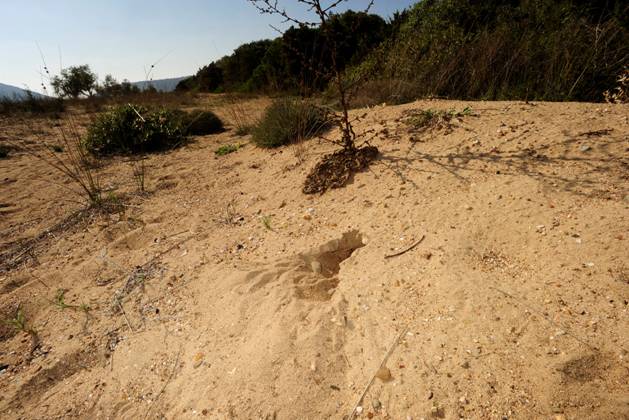
The nest pictured above is just one of many which have been placed in the nesting mound we erected some years before.
Other project activities in the year 2009
The traffic calming measures prove to be successful
The "bumps" positioned on the street in 2008 for regulating the speed of vehicles have proved a big success, there are almost no speeders here any more. Due to this, the number of street kills has decreased in the year 2009 compared to the previous years. In this connection, one noticeable observation was the discovery of 15 Western sand boas (Eryx jaculus), compared to 1 - 3 animals per season in the previous years. We see the traffic calming as significant cause for seeing more and more of these severely endangered species, listed in the EC agreement appendix I.

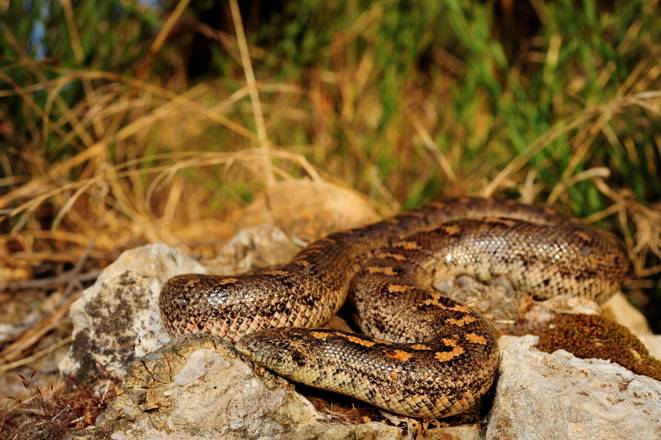
Anyway, also 14 dead chameleons, killed by vehicles, have been found in 2009.

Considering the population size of 350 animals, this loss caused by traffic is 4%. Compared to the previous year with 10%, a considerable decrease of losses could be reached. Apart from that, 13 other reptiles, 3 birds and some small mammals were documented as street kills.
Ornithological observation
The lagoon is an important resting place for various migratory birds and, as such, documented ornithologically. Aim of this documentation is to get an insight into the migratory behaviour of the birds, as well as into the development of the population on their routes.

For monitoring the environmental conditions, a water sample of the lagoon was taken twice a week. Changes in the water quality, for example by contamination or salinization, could be detected in time and it was possible to fight the causes.

Cleaning of the channel
A water channel on the border to the A-zone of the Natura 2000-area has been freed of reed in July 2009. With the commitment of our helpers, rubbish and plant parts were removed from the water to create more open water space. This creates new habitats and facilitates the observation of water animals such as green toads, terrapins and turtles, grass snakes and dice snakes. In these habitats, the natural behaviour of the animals can be observed without disturbing these animals.

Guided nature tours
In the year 2009, we have offered visitors interested in natural history guided nature tours at leas twice a week. Additionally, observation huts and a high seat are provided. Theses had to be maintained in 2009 as in the years before. We put up new benches as well.
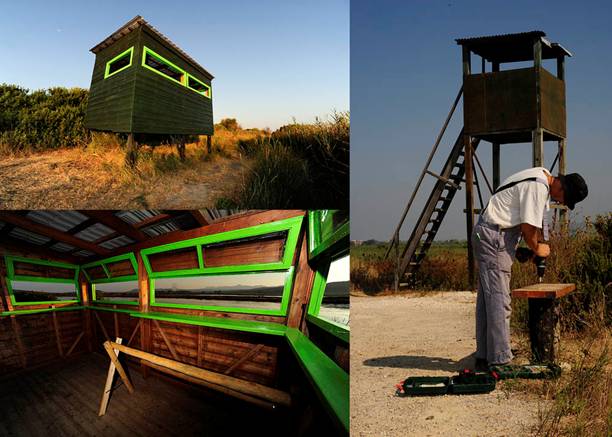
The information centre
The information centre in the old pump house which had been completed in 2008 proved as success in 2009. Far more people interested in nature could be reached and informed, more than in the previous years.
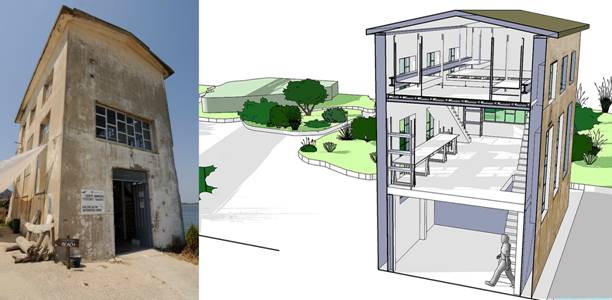
The new beach bar
The new professional beach bar "Kantina" in the centre of the area has brought much more problems during the complete season 2009 than in all the years before.
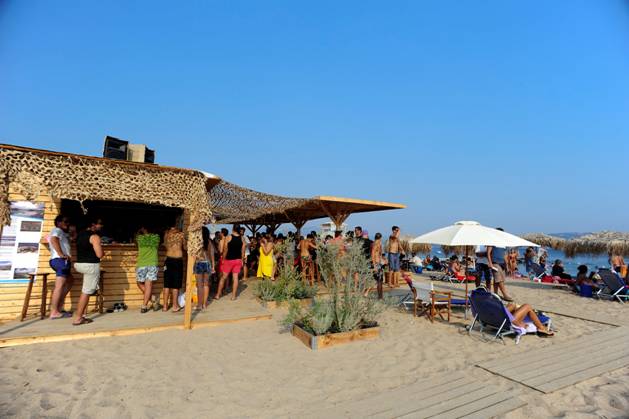
Due to a massive promotion campaign, the beach tourism has increased extremely, which has led to a much higher traffic in the area.
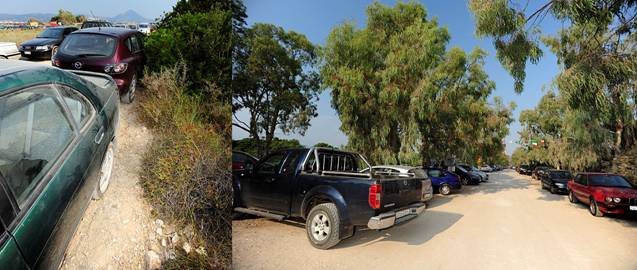
Infringements of concluded agreements
The usage agreement between the Archaeological Society and the owners has been ignored by the latter in different regards. One example is that more than twice as much beach chairs and beach umbrellas have been put up than allowed in the agreement. The more than more than generous "exceptions" are actually part of the agreement; there is hardly one single point that has been observed. Please see for yourself - in the document made available here.
Here is the original agreement: agreement , translation in progress: translation(de)

The picture above shows the extent of the infringement: The darker umbrellas are the ones which have been put up originally, new lighter ones are new. At the end of the season, our helpers counted 190 umbrellas instead of the agreed 100. The original image data does not make counting easy as the umbrellas are put up really close to each other. Unfortunately, we do not have an aerial picture so far. Nevertheless, it is clear that the agreed number of umbrellas has been exceeded by far.
„Full Moon Parties“ on the chameleon nests
The closing time of the Kantina around sunset was generally exceeded. The tranquillity of the area was, sometimes even at time, disturbed by loud music and events ("Full Moon Parties", live concerts etc.) enormously.
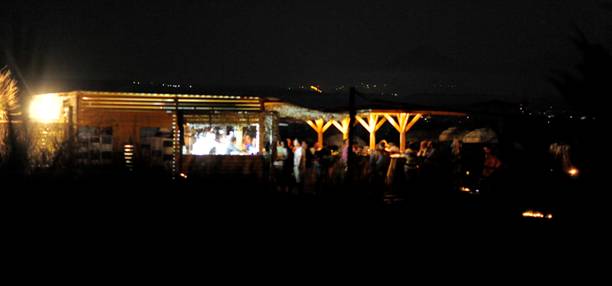
The authorizations from the Archaeological Society for these events have been obtained without our knowledge. The Archaeological Society has presupposed our consent in writing - against our decision.
The limits regarding times and loudness have been exceeded massively. The 24-hour-active generator and the lighting of the Kantina during the complete night disturb fauna and environment. This means that nests of the loggerhead sea turtles are very unlikely during the complete summer in this year. Also, the young chameleons that hatch near the Kantina can be misled by the bright lights.

A short explanation: To understand why the shy chameleon females choose this environment for their nests, here's a short explanation. Usually the Kantina is dismantled at the beginning, or latest in the middle of October. Except for individual walkers, there are hardly any persons in this area then. At this time, at the end of September until the end of October, is the oviposition time, in which the females usually got to the same places at which they have been hatched themselves. Originally, the best positions for the oviposition are at the centre of the area. And exactly that is the area where the Kantina is in summer, meaning during the hatching time of the young animals.
Approached regarding these disturbances, because we were trying to find a solution, the owner (Fotis Karabatsos) and some of his employees reacted with aggressive behaviour, insults and threats.
The eternal and annoying litter problem of the "Kantina"
Due to the professional promotion of the Kantina owner, more tourists than ever before have been attracted to the beach which made things even worse. The littering resulting from this is completely unacceptable. The contractual obligation to keep the area (200m) around the beach bar clean has not been observed at all.
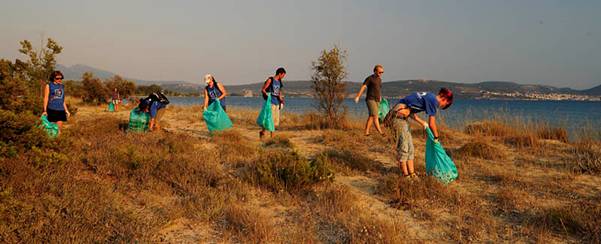
Just like in the last years, we were the only ones who ever cleaned the beach, the streets and parking lots of litter, with the exception of an occasional clean-up organized by the mayor.
The following picture shows the result of one single average litter collection.
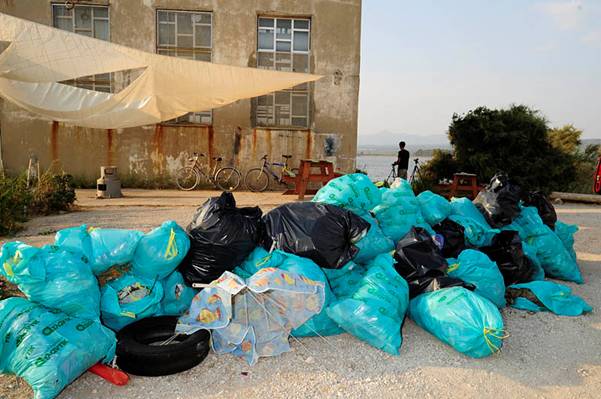
The next pictures have been taken along the Kantina parking lot.


The only area that was cleaned daily was the one between the beach chairs, meaning the area important for tourists - from the owner's point of view. Even the entrance areas for their Kantina were left to themselves and to the wind. The result: Huge amounts of plastic cups are littered across large areas of the dunes and the beach.
The biggest part of the plastic litter could easily be identified by the writing on the cups/the package: Litter of the Kantina (see arrows).
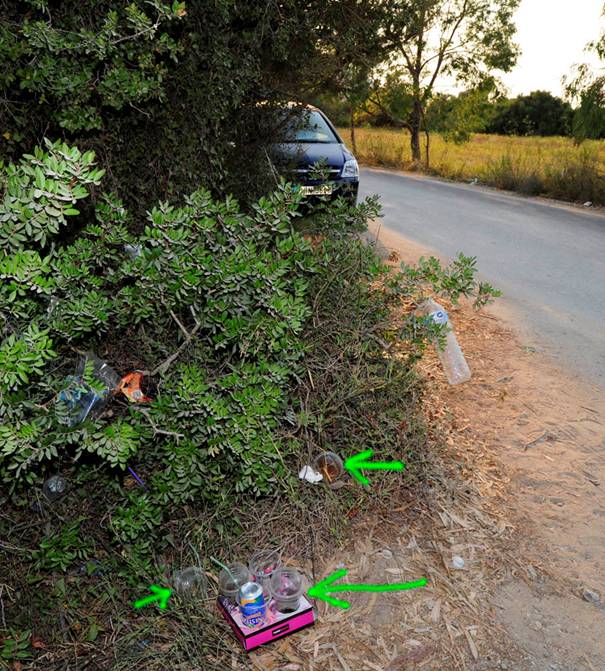
It becomes obvious that a considerate and careful usage of the area by a professional beach bar of this size cannot be realized.
During the complete season 2009, the beach outside the beach chair/umbrella area has not been cleaned, not even once. Even between the umbrellas, some thousand cigarette buds were lying in the sand. Obviously, the beach bar owner did not even consider removing them.

Regardless of our fences in the most important nesting areas, these were abused as toilets directly next to the Kantina. Considering some hundreds or even thousands of tourist visiting this beach, this results in hygienically critical conditions. The smell in these areas, especially in the habitats of chameleons and other rare species, was unbearable and pungent in August. The contamination by faeces has reached worrying proportions in 2009 which should be seen as a real hygiene problem.


In the picture below, you can see a chameleon nesting that had to be secured next to rests of toilet paper.
Tensions regarding the Hellenic Ornithological Society (HOS)
The Hellenic Ornithological Society is the supporting institution of the project and for the protection of the african chameleon. After years of successful cooperation, the first discrepancies occurred in 2009, when Xenophon Kappas, the director of the HOS, appointed himself project leader.
Unfortunately, Mr. Kappas does not have any knowledge of the biology of the african chameleon and its habitat. His training as business administratior did not give him any insight in biology or ecology, as he admitted in personal conversations with Mr. Ehrlich and Mr. Trapp. He also does not know much about the conditions and special circumstances, local history and local problems, as he has visited the area less than ten times in person. His assumption, that such a complex protection project with very special circumstances can be managed from Athens, 300 km away, especially when faced with such threats, led to the degrading of the long-time project coordinator Marilia Kalouli at the time of his self-appointment. Mrs Kalouli had led the project from 1997 until that time - and on-site.
With the arbitrary decision of Xenophon Kappas to suspend the former project coordinator, the project staff lost their indispensable contact in situ. Up to this point, Mrs. Kalouli had been the central contact and was able to reconcile the interest of the project with that of other parties and, if required, to mediate successfully due to her knowledge of Greek and her diplomatic skills.

Marilia Kalouli in contact with local official in the year 2008
From this point on, the communication between the project management and the staff in Pylos deteriorated. Counter-productive instructions and the change of the project structure were only communicated via third parties.
There was no transparency regarding the project's financing and a donation of 60,000 Euro by the TEMES was not forwarded completely. An that was money the project needed urgently.
Apart from that, the director of the HOS taking over the project management presented an intervention in established measures regarding public relations and the project work. One example is that the project team was enjoined from performing the guided herpetological tours for visitors interested in nature, a big success since years. The guided tour, especially popular with children and young people, had attracted not only foreign visitors, but also some hundred Greek visitors. At the location, they had the chance to see turtles, lizards and with some luck one of the two tortoise species, one of many snake species and even a chameleon. It is the opinion of the team that the aim of the reptile protection project to arouse this kind of enthusiasm, because most people encounter these rather alien animals with prejudices, fear or even hate, because they don't know much about them.

At this point of time, unity and cooperation would have been so important, as the area is under great pressure by a huge planned building project by the operating company called TEMES. The plan includes 3 golf courses and 2 hotel resorts with a total capacity to host 6.680 tourists. It is indispensable to communicate intensely with TEMES with dedicated expertise of the protection zone and its inhabitants, to find solutions for a permanent protection of the area.
But the role of a mediator between the biggest interest groups (in particular the TEMES) was given to the "Special Consultant" appointed by the HOS. The actual project team was cut off the communication completely by that. Unfortunately, the decision competence got into the hand of someone without any special knowledge of the area and its inhabitants. The comments of Mr.
Teneketsis
so far in the Greek press (see article below) and his communication with the project team leave the impression that Mr.
Teneketsis
might not really act in the interest of environment protection in the first place.
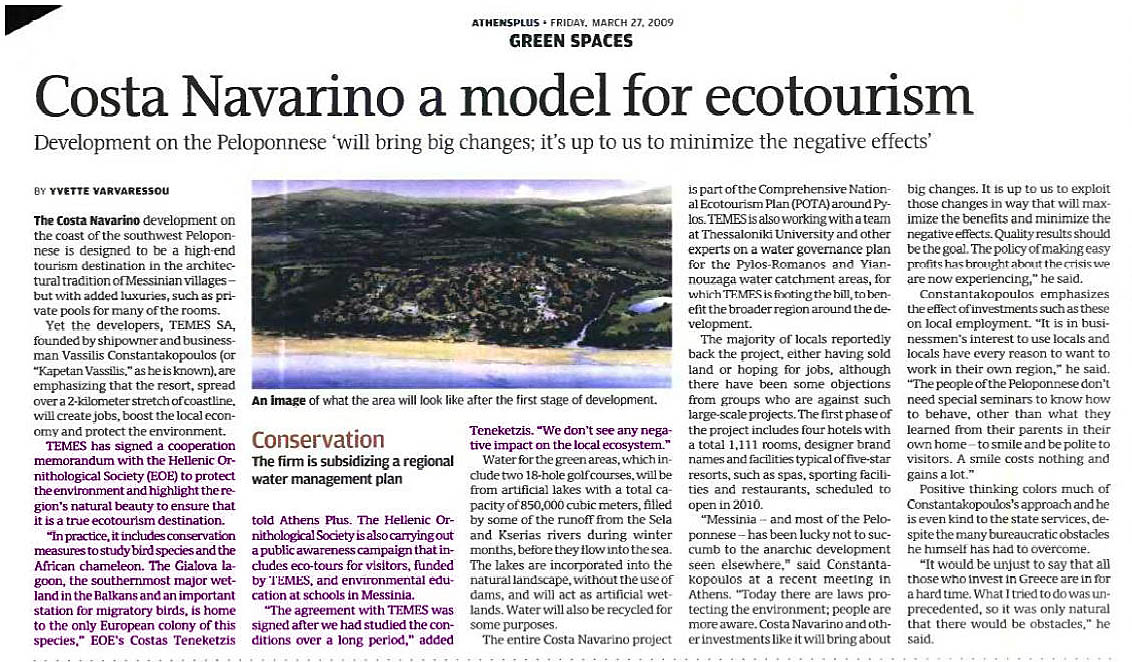
We, the project staff, cannot understand such comments and numerous others and the corresponding procedures. Considering the imminent tourist "development" of the area, a competent and serious dialogue between conservationists at the site and TEMES would have been required to find solutions for the environment protection. The team was not informed about any meeting between the representant of the HOS, Kostas
Teneketsis, and TEMES and its potential results!
Instead, untruths and cover-ups led to a serious distortion of the actual circumstances and the chance for a dialogue seems to be gone. Statements of Mr.
Teneketsis
which said that the erection and operation of a giant hotel complex with 3 golf courses right next to the Natura 2000-area have no influence on the neighbouring eco system according to the HOS, one of the biggest nature conservancy societies, leave us perplexed.
The dispute regarding the unbearable circumstances around the "Kantina" have led to some unfortunate and regrettable development within the chameleon project which we would like to comment in the following.
Visit from Athens
On invitation from Mr. Trapp in August 2009, the director/project manager Xenophon Kappas and a board member which has been voted out by the members of the HOS meanwhile, visited the protection area. They had come from Athens to get an impression of the conditions for the chameleon project at the location.
At this occasion, the director was informed, amongst other things, about the verbal attacks and threads against the staff responsible for protecting the nests. Mr. Trapp was then prompted by Mr. Kappas to keep away from the area around the Kantina so he would not "provoke" with his presence there.
Trusting on Mr. Kappas to solve the problem "in another way", as he promised, Mr. Trapp followed his instruction, though in particular his presence was required due to his tasks (legally authorized) in this area. Mr. Kappas advised against an official complaint against the owners of the Kantina as demanded by Mr. Trapp and Mr. Ehrlich. The project staff had to succumb to the promise that the HOS would solve the problems "more effectively" and "less provocative", against their will.
The tensions increase
In the following, there were even more insults and verbal abuse, even outside the Kantina area, against the helpers, even when others witnessed this. Unannounced events and permanent noise were the order of the day. The project assistant responsible for the protection of the chameleon nests, Benny Trapp, did not see himself able to perform his tasks as agreed and to ensure the project priority: Successful hatching, and as many young chameleons as possible.
No support from Athens
The ruthless proceeding and the inappropriate behaviour of the Kantina owner can only be described as unacceptable and unbearable, even with a more laid-back manner. The direction of the HOS reacted with the usual patterns of behaviour: doing nothing at all. The project assistants have thus written detailed and descriptive letter ( yellow marked bits were censored Original document), as a complaint for the responsible authorities. As such a letter can only be authorized and signed by the project manager, in this case the director of the HOS, the letter was send to Mr. Kappas with the request for help and forwarding the letter. In the opinion of the project staff, the documented form and extent of the grievances around the Kantina were enough to have the operating license of the Kantina owner withdrawn, to ensure the survival of the project.
Arbitrary censorship
With much consternation, the project staff discovered that the director had not forwarded the letter as it was, but shortened and censored, leaving out important facts. ( Original document).
He also decided that the letter would be send in the end of the tourist season instead of immediately something that was totally against the team’s opinion. But the most important was that instead of sending it to the Authorities, he decided to send it to the owners of the kantnia, and was only coppied to the authorities. In addition to that some important addresses like the District Attorney, that would have taken immediate measures against the illegal actions of the Kanteen, were crossed out. The operator of the Kantina received the letter four and a half weeks later and unfortunately only at the end of the tourist season.
The letter resulted to a presentation of facts, with the recommendation that these should not happen again. The following demands that were original in the letter were removed from the director:
- The demand that the Kantina is removed from the core zone of the Natura 2000 area.
- The number of umbrellas and beach chairs that should be not more than 100.
- The obligation of cleaning in an surrounding of 200m around the area used by the Kantina.
- The the obligation of closing time at sundown.
- The obligatio to shut down the generator of the Kantina at night (about 80 dB, measured with a decibel device from 1m distance).
- The prohibition of events in the night time in the whole A zone
- The prohibition of any lights at night.
- The Prohibition of music and any sound system establishment in the canteen.
- The prohibition of flags and promotion posters on trees and along the road in the A zone of the area.
- The obligation to respect and cooperate with HOS staff and volunteers and to accept recommendations that are made for the protection of the environment The request to remove the whole installation at the end of the tourist season.
The Archaeological Society, which is responsible for the lease contracts, did only get a copy of this censored letter. This made the letter look like a copy for acknowledgement and not a formal letter of complaint. The written answer of the Archaeological Society to the HOS which the authorities received only at the end of the tourist season included the following passages:
"...the recommendations of the Hellenic Ornithological Society to the operator of the Kantina (Divari-Hotel-Touristic Co.) in the respective letter have been received by out authority at the end of the tourist season which made it practically impossible to take action.
and
"...we ask the Hellenic Ornithological Society to inform us in time of such infringements in the future to have enough time to react..."
Here is the original document (in Greek): ( Original document)
As a reaction, the project team wrote a letter to the director and the board of the HOS to describe the grievances of the past weeks and months in detail( original document). The director/project manager was invited for a extensive conversation at the location. But instead of a constructive dialogue and instead of referring to the content of the letter, the instant of the director was to dismiss Marilia Kalouli by telephone, who had send the letter in the name of all project assistants. There was, so far, no reaction to the letter of the project team.
By this, the chameleon project lost the person with the most experience in the contact to authorities, the mayor, residents and other parties involved. Being a native Greek, Mrs Kalouli had been the "mouthpiece" and mediator in Greek language. Since then, it is no longer possible to communicate with authorities and the operators of the Kantina in the national language which made the situation even worse.
The end of the project work
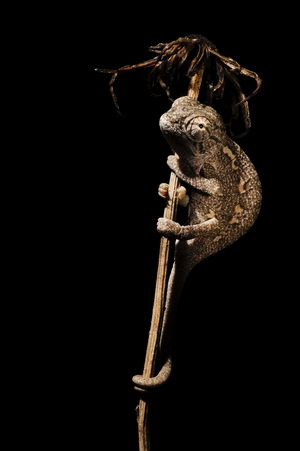
Though the time of oviposition was near, the employment contract of another assistant (Nicos Liberopoulos) expired and the coordinator for the volunteers had cancelled her contract due to private reasons the OHS did not think of replacing these people.
Apart from only a few helpers, only the project assistants Benny Trapp and Klaus Ehrlich from Germany stayed to ensure the protection of the nests, as well as Nico Bedau, whose task was creating the „Visitor Guiding System“ (Management concept for visitors) ( visitor guiding system). This lead to up to 16 working hours per day for the rest of the chameleon season.
Not resulting from some kind of solidarity with their former colleague, but form a feeling of helplessness, these last assistants and helpers cancelled their work contracts with the Hellenic Ornithological Society with instant effect. The reader can only guess which fatal consequences the inactivity and the wrong decisions of the HOS have for the protection area, its fauna and last but not least for the chameleons.
The project had practically officially come to an end!
Summarized, the situation of the chameleon project was the following at the end of the season 2009:
The information centre, completed in 2009, and the kiosk in Gialova have been closed in mid-September. This means that in the most important tourism time no more educational and informational work could be made, in a time when the most tourists interested in nature are in the region. In contrast to the previous years, there was no event on the "International Bird's day" in October, an event which enabled us to present our work not only to tourist but also to residents, members of authorities and may other people. This day also attracted press and TV and our work was introduced in the respective media. We do not have the income from selling souvenirs and information material as well as donations any more, and the guided tours in the lagoon are a thing of the past. As well as the environment education in regional schools and other public institutions, except one trial.
The project assistants Benny Trapp and Klaus Ehrlich know their responsibility regarding the protection of the environment and endangered species, so their cancellation of the working agreement only referred to their cooperation with the HOS and their board and the director Xenophon Kappas. The measures required for the protection and thus the survival of the chameleons have been continued by the project staff until the end of the chameleon season 2009. Additionally, the work on the „Visitor Guiding System“ ( visitor guiding system) was completed by Mr. Bedau. This was then sent to the Hellenic Ornithological Society and is available to the officially responsible organisation. For obvious reasons, other important works were also continued.
As the authorization of the Greek government for the chameleon protection work is for the person Benny Trapp and not for the Ornithological Partnership, Benny Trapp and his assistant Klaus Ehrlich were, regarding legal aspects, on safe ground. The other
volunteers
of the project, made insecure, assured their helpful support to these two and also dissociated themselves from the arbitrary and irresponsible decisions of the HOS management.
In spite of the staff shortage and the readiness of the responsible persons to continue the protection-relevant activities until the end of the oviposition-time, more and dearly needed helpers were called off shortly before their journey to the area.
This all meant that the end of the year 2009 was rather sad due to:
- Massive tensions within the Hellenic Ornithological Society
- Disapproval of the HOS politics in the population
- Cancellation of dissertations
- No future perspectives
- Temporary solutions cannot be carried out because of incompetent replacements for the year 2010
Dear reader, you see that the situation and the prognosis for the Gialova lagoon with its inhabitants is, in spite of the fantastic population development as result of the protection measures in the last years, very critical at the end of 2009. Especially the african chameleons face an insecure and rather dark future as it is not clear what will become of the project. We, the project team, regret the current development and really hope we can continue our work in the interest of this unique protection zone and its endangered and rare species.
In the following some pictures to show you the beauty and the uniqueness of the Gialova lagoon.

More pictures here.
We would like to thank our members, assistant and helpers who helped us in the past years with much enthusiasm, lifeblood and energy with the realization of the protection measures - we could not have done this without you! To see your optimism and joy to help in the Natura 2000 protection zone has given us the power not to give up and keep on working in the past years.
Which threats and which future are to be expected for the area, its flora and fauna? Read more in the following.
Employment of a new, inexperienced project team
Regarding the events of the second half of the year 2010, we are afraid that the chameleon population is exposed to numerous risks and dangers. It is already obvious that the protection of the Gialova lagoon and the african chameleon is suffering a setback due to a lack of care by an experienced and engaged project team. At the time being, there is no real project management. The helpers do not have any real training and support or supervision, and the measures and plans lie idle. The beach bar is constantly expanding without anybody doing something against it.
Alleged "science" as threat
As this complex but rather "dry" theme disturbs the read flow somewhat, please open the text in the following window:
„Failed „cooperation“ with Uni-Patras“
(translation will follow)
The parking lot of the Kantina
In the summer of 2009, the assistants of the HOS, Marilia Kalouli and Nico Bedau, were asked by the owners of the Kantina whether or not they could agree to expand the parking lot. They said that the parking lot should be expanded to the north (see sketching, blue marked area). As this place has regularly been a oviposition area of the african chameleon, the Greek tortoise and the European terrapin in the past years, they could not agree. Apart from that, this area is also the habitat of many endangered species, which the chameleon project wants to protect and the Natura 2000 area has been set up for this. The environment protection project had the aim to protect these areas and not to erect more parking lots to bring more cars into the vulnerable area.
At that moment a Visitors Management Plan was being conducted by Nico Bedau and Marilia Kalouli to deal with all the problems of access, parking spaces, and controlling of visitors in the A zone. The study was finished and handed to HOS in March 2009. However, HOS has not yet submitted the study to the Ministry of Environment or to anybody else, leaving again the area open to any touristic development proposals.
( visitor guiding system)
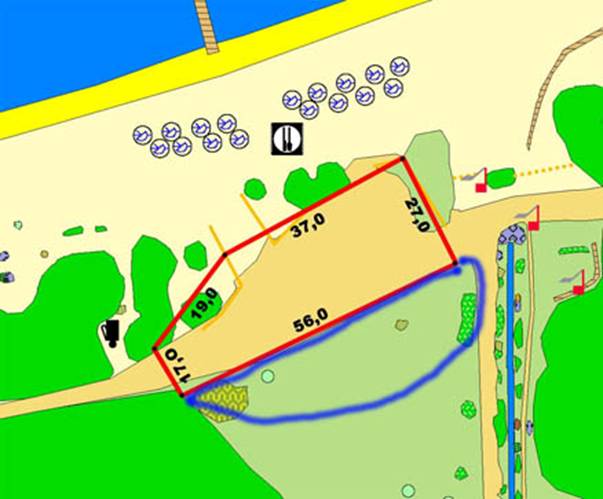
The sketching shows the area of the Kantina in the year 2005. There were only 17 beach umbrellas in front of the Kantina, in the year 2010 there are more than 160! The read area shows the present position of the parking lot. The area marked in blue show the oviposition place and the habitat which is to become a parking lot.

These two nests are in the area of the expansion of the parking lot and would be destroyed. In the background is the parking lot and the trailers of the Kantina.
(25.09.2009)
The asphalt road
The asphalt road which goes right through the area ends at this parking lot. On this road, we found numerous road kills of vertebrates, mostly reptiles and dozen of chameleons (they are dissected in alcohol, the number is verifiable). The road ends behind the parking lot, westwards, in a dead end. This bit is a gravel path which is driven less (and with less speed). Here, there were less dead animals in the past few years, despite a similar number of individual chameleons and a much higher population in the overall area. We fear that the more and the sooner this area is "developed", this will also become an asphalt road. Regarding the length of this bit, the number of road kills would be rise by 100%- twice the number we have now.
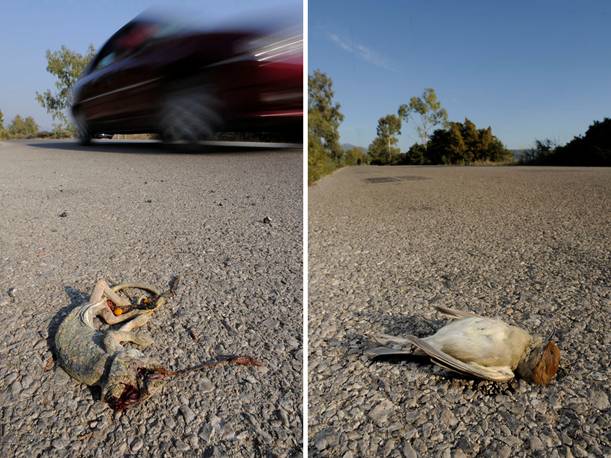
Yearly road kills on the asphalt road by speeders and high number of cars.
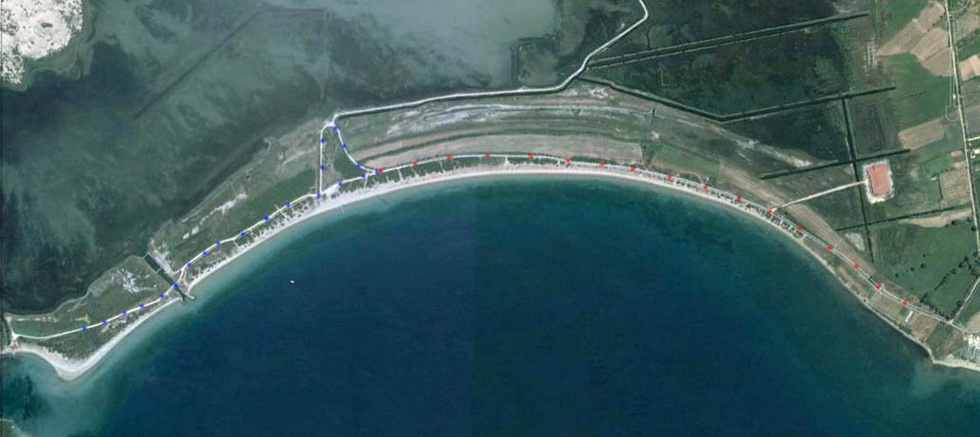
Marked in red: Asphalt road marked in blue: Gravel path
Inexperienced helpers endanger the hatching success
„…because they don't know what they are doing…“
The problems resulting from the nuisances in 2009 have set back the project, which has been developed in more than 10 years with lot's of work, with one blow. The Hellenic Ornithological Society has employed a provisional project team with the help of Kostas Teneketzis. This consists of inexperienced staff, recruited from his circle of friends, and some less qualified helpers of the early years .
The project team until the end of 2009:
M. Sc Environmental Policy and Rural Resources, Assistant-Coordinator between 1997 and 2000, project coordinator since 2001.
Field herpetologist, responsible for chameleons since 2002
Biologist, ornithologists, founded the Gialova project in the year 1997.
Landscape architect, works for the Gialova project since 2006.
Biologist, M.Sc. in evolution biology and systematics, field assistant of the project since 2005.
Local caretaker, works for the Gialova project since 2003.
This is the team of the year 2010. Most of the people do not have any background knowledge or experience:
Chemist, no field experience, project coordinator
Field herpetologist, supervisor for chameleons, has been dismissed by the HOS during the LIFE project due to questionable methods.
EVS trainee 009, no qualifications. Responsible for chameleons in 2010.
Local Caretaker, works for the Gialova project since 2003.
Presently, a volunteer of 2009 is responsible for the chameleons, Thomas Carlos des Francs. He has been trained with the basics of the necessary works by us, but his knowledge of the biology of the chameleons and the other herpeto-fauna of the area is rather small.
As supervisor, the art teacher and freetime- herpetologist Giorgos Chiras from Patras has been employed, who can only visit the location sporadically due to his real job as teacher. Mr Chiras has already worked for the LIFE project in 1999 but had been dismissed due to questionable methods. One example was catching animals and carrying them around in his bag to show them to people, pressing the pregnant females to lay the eggs, or moving them around, changing position of the animals, being unable to follow the protocol or fill in the data forms, dealing with volunteers at his own will and creating conspiracy theories.
This means that, in our opinion, there is no qualified or sufficiently trained staff, or staff sensitive for the theme environment protection, to help protecting the area and its fauna, employed by the HOS. This may mean that the currently performed measure are not only useless, but even counter-productive.
One example: In the past years, we have taken up the young animals when they left the nest and put them in the surrounding bushes, due to the small number of hatched animals. This was done to protect the few young animals from predators like martens, cats and foxes.

Helper performing a sex determination during the hatching period in the year 2009
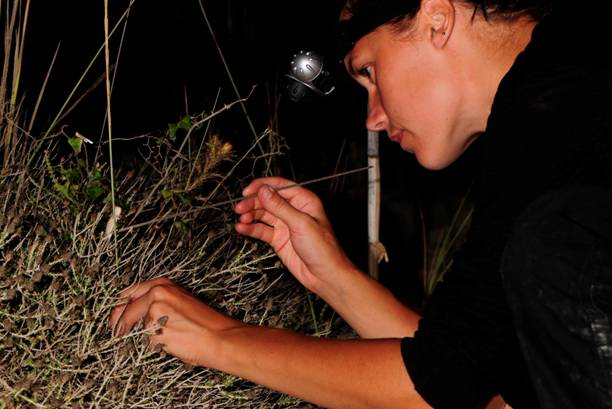
In this year, the hatching season (August to October) has already begun. From 170 (estimated 200) nests, 20 to 50 young animals will hatch. With 6000 expected young animals. Taking each animal up and putting it in the bushes is not only completely unnecessary, but also not in the sense of a useful protection work. But instead of understanding these circumstances and just doing some statistics about the hatching, the currently responsible ex-helper Thomas Colas des Francs just does what he believes to have learnt in the last year. Believing they would do something useful for protection chameleons, all helpers run around the nesting area, once or several time a day, and endanger the nests on the floor by that!
The important prerequisite for this "starting help", which has been performed in the past few years, has always been the knowledge of the exact nest position to ensure that no one coincidently steps on a neighbouring nest and one of the tiny young animals. Only by looking on photographs, the helpers had searched the area for nests that can be localized exactly, from a safe distance, to prevent any damage.

Even at day time, a nest can be overlooked, even one with an adult female,
which is shown in the above picture of October 2009.
In the picture below, you can see the exit of a nest (in the middle of the picture). The tiny footsteps show where the young chameleons are hatched. Aim of the barriers in the nesting area is to protect the nest and the animals from being stepped on, and to prevent the helpers from doing so.
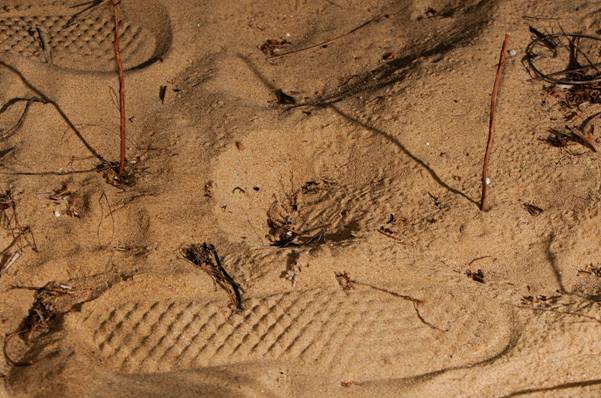

Animals that hatched in the night are hardly visible with a length of only 3 cm. With the high number of nests in the season 2010, walking around the nesting area at night time is far more dangerous for the chameleons than the natural predators.
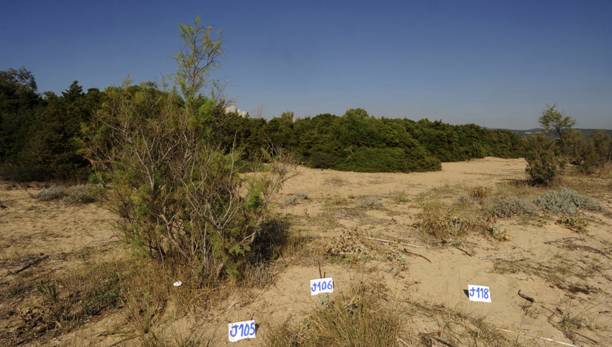
Often, the nests are very close to each other, as shown in this example. If a wrongly instructed helper gets active here, he steps on the other nest, not even knowing he does!
The current project team has no knowledge about the nest positions, as they do not have the photos. We fear that by this blind behaviour, the hatching success of the year 2010 is in danger, as the helpers step on the nests and the young animals during their night-time search (the animals hatch after sunset).
The activities of the protection project should have included, before everything else, the effort to close or relocate the Kantina, the protection of the population and more barriers in nesting areas. Only with this background, a safe population development can be guaranteed. But none of this has happened so far.
The negative developments in the area of the Kantina
We expected the nuisances around the Kantina would continue or get worse in the year 2010. Unfortunately, we were right with that. It seems that the alleged efforts of the director of the HOS to clarify the circumstances and to elimination of the threats did not show any effects so far.

And that despite the explicit written request to the director of the HOS by the Archaeological Society to report any wrongdoings against the agreement instantly, so the Archaeological Society can take active immediately (see above):
You may understand things better, dear reader, if you learn that the current owner of the „Kantina“ Fotis Karabatsos
was the real estate broker of TEMES
who gave 50,000 Euro for the Pylos protection project to the HOS in 2010.
Unfortunately, the tourist activities in the area of the Kantina have become even more in 2010. Again, there are far more than 180 beach umbrellas and chairs in the core zone for the oviposition (August 2010). And this in a "Natura 2000" area - think about that for a second!
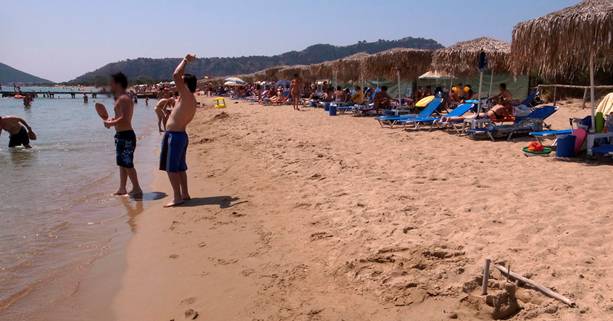
Is this Palma de Mallorca? Or is it "Natura 2000"?
Under the link below, you can see several short clips documenting the current situation (August 2010) around the Kantina:
Youtube-Video: Divari buisness August 2010 Panorama
Youtube-Video: Parkvandalismus
Youtube-Video: Divari buisness August 2010
More picture about the unfortunate situation of the nesting area of the african chameleon
in the core area of Natura 2000 caused by the Kantina.
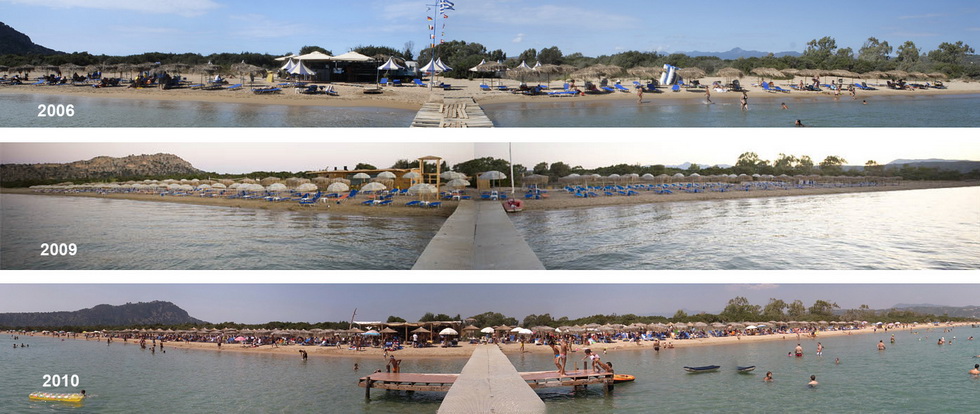
Swift action is essential!
To guarantee a permanent protection of the chameleons, rigorous action of official and responsible bodies in the Hellenic Ornithological Society and the Archaeological Society against the expansion of the Kantina is urgently required. Only by careful management, it is possible to reconcile the interests of tourism and environmental protection. In these careful efforts to ensure a long-term coexistence of human beings and their natural environment, there is no place for reckless profit seeking of individuals who do not care for this unique bit of nature at all.
So what is a "Kantina"?
Normally, a Kantina in Greece is a sort of lunch counter on wheels who offers snack and drinks. What has been authorized in the past by the Archaeological Society in the scope of annual special case authorizations (for a lease price) to offer the visitors some kind of infrastructure inside the Natura 2000, has now become a giant catering company. As a Kantina is supposed to be moveable, it should leave the area at night time, as it is standard for a Kantina in the true sense of the term. Alcoholic drinks instead of refreshments, huge loudspeakers, volley ball fields, such a large number of beach umbrellas and chairs do not have anything to do with the true character of a Kantina! And, just for the case anyone wants to know, there is no authorization for a beach bar. Since more than ten years, the once small Kantina has developed, with the help of the business-minded owner, into some permanent institution.
A look into the past:
The first beach chairs and umbrellas have been set up by the former owners of the Kantina, several trailers have been combined to a big bar with a terrace made of wood. They also erected a beach volley ball field and so on. As generator, they used an old tractor and then a fixed, smoky and loudly roaring diesel generator. The following pictures are from August 2004:

After a season, the owners of the Kantina disposed the waste oil and the diesel in the simplest possible way - they discharged it into the sand.
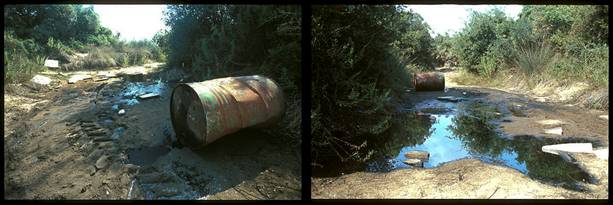
After a complaint to the mayor's office (the police did not feel responsible), the corresponding area was simply covered with some soil some weeks later. Thee has never been an excavation until now. Responsible for observing the compliance of the policies, and for some of the authorizations, is, apart from the Archaeological Society, the Mayor. In this connection it is sort of precarious that the acting Mayor until 2007 had been participating on the economic success of the Kantina until his death. In 2008, the health authorities ordered the Kantina to be closed because the freezer, filled with meat, had not been cooled and the contents decomposed, the Kantina stayed open until the end of the season nevertheless...
Back to the future
Every two years, the authorization for operating the Kantina in the protection area is sold in an official auction. Here, interested parties can make a secret offer for the monthly rent, which does not have to be paid only during the season, but for the whole year. After more than ten years, the Kantina got a new owner in 2009. One of the new operators is actually Fotis Karabatsos, the realtor of the TEMES (remember: The TEMES sponsors the HOS with more than 50,000 Euro in the year 2010). he got selected in the process, with a bid of a sum of more than double the amount of his predecessors, and set up a professional beach bar instead of a classical Kantina. Despite the change of operators, the situation did not get any better, it got worse. As documented in the current pictures and clips, the trend is even more beach chairs and umbrellas in the protection area. The expansion of the Kantina has not stopped: The generator is put in the fenced off dunes, directly with the chameleons.

The waste oil is not discharged in the old way, but fluid spills out and still contaminates the soil.
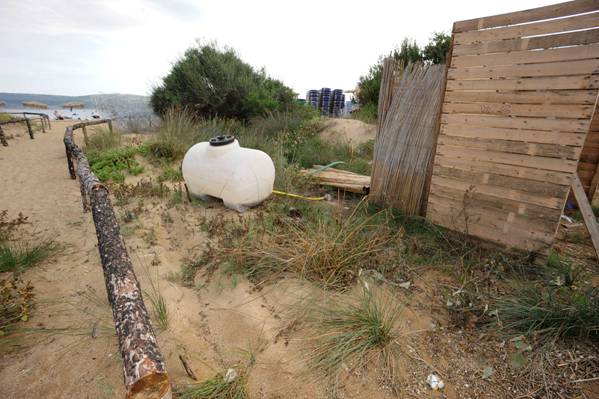
The permanent noise of the generator which even runs in the night now is only drowned out by the music sonication from noon to night from giant loudspeakers. After the tourist season 2009, the umbrellas taken from the beach were not collected, but thrown into the dunes, during the hatching time of the chameleons, and picked up only weeks later. This happened without any official reaction - ask yourself why...

When the request of Mr. Karabatzos for a special authorization to leave the Kantina in the protection area after the season for the whole winter time was rejected, this almost came as a surprise!
Another big threat for the area and its chameleons is the huge tourism project which will change the conditions for fauna and flora forever. Read more in the next chapter.
- Paradise lost - and international environment protection project is reduced to absurdity!
What happened before
The Natura 2000 area adjoins 2 golf resorts, one in Romanou and one Pylos, of almost unimaginable dimensions . A whole hotel city has been erected within few years and a part of the megalomaniac project has been opened some weeks ago. To give you an impression of this most expensive project, co-financed by the EU, we have collected the following information from the website of the operators TEMES.
According to this information, the following is planned and partially completed, and this involves only the Romanou golf resorts:
- 11 5-star hotels (with more than 3,000 residential units)
- Villas and private houses with 123 planned pools
- 7 (SEVEN) golf courts
- 6 Thalasso therapy centres
- Conference centre for up to 2,000 visitors
- > A marina
More information about the dimensions and the aims of the monstrous project on the website of the hotel- and golf resorts: http://www.costanavarino.com
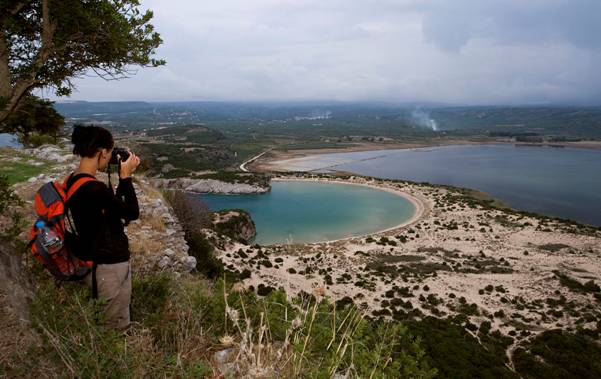
View of the almost untouched lagoon and the bay (2009)
Imminent tourist usage of the area
Apart from the enormous space requirement of the planned project the question is where the immense amount of water for the golf courts, 123 private pools and showers and toilets for the planned 4,500 persons should be taken from. According to the plans of the TEMES, there are only three basins for taking up rain water and two small flowing waters are intended.
There is an expertise saying that taking the water from the environment will not have an influence on the salinity of the lagoon. That this shall be performed without influencing the water balance of the region, according to the TEMES (see article), this is hard to believe.
Everyone can image which big influence the change of the environment caused by the building operations, the transformation of nature habitats into golf courses, the water consumption, the redirection of rain water and the presence of several thousand guests a year has on the neighbouring Natura 2000 area. |
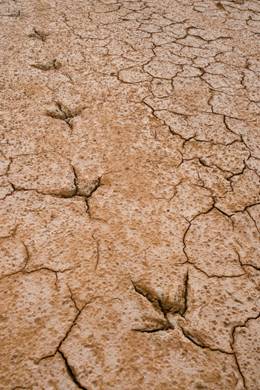 |
Usage of the bird resting place and the hatching area
Apart from that, there are efforts to change the usage conditions of the lagoon, which are regulated in the fishery laws, fundamentally and to expand these conditions. The details of these efforts are not yet laid open, but they are probably targeted towards touristic usage of the area. It is clear what this means for the sensitive inhabitants of the lagoon, such as the 350 flamingos which came to lagoon looking for food yearly.

Flamingos in the lagoon of Gialova - this is, next to the controlled fishery, the only responsible "usage" of the wetland!
Which consequences the usage of the lagoon for touristic operation such as boats, surfers etc. has for birds, looking for food or a place to hatch, and for the complete fauna of the habitant, cannot be assessed yet. Apart from the controlled fishery in the lagoon, there cannot be any other usage for the lagoon. This would not have anything to do with the "eco tourism" praised by TEMES and HOS, even less than the Palma de Mallorca-tourism on the oviposition areas of the african chameleons. We are afraid that irresponsible statements of HOS staff could lead to the lagoon being released for touristic usage of even the lagoon (such as the nesting area of the chameleons has been released for the usage of the professional beach bar).
Strange!
The current usage plan for the lagoon allows only controlled fishery by one fishery company. This is how overfishing could be prevented and the lagoon could be used by local economy anyway. From 2003 to 2009, the fishery right was given to the company of Giorgos Stavrianakis. In tight cooperation with the project, progress was made, illegal fishery in the core area of the Natura 2000 area was prevented by common surveillance and mutual support. Mr. Stavrianakis has been an exemplary manager who has a distinct responsibility for the environment.
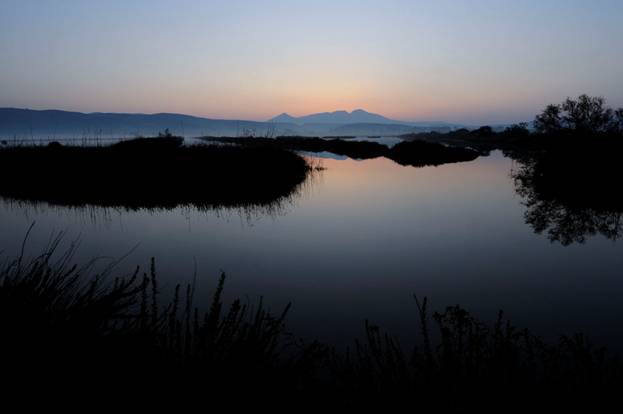
In the last year, his licence was withdrawn with the justification that the lead concentration (Pb) had been found in the water. Only a few water samples had been taken and the results had not been made public, which makes the whole affair rather questionable. Apart from that, we asked the marine research institute for a comment and they said that a lead concentration cannot be possible as there no sources for lead in this area that could be responsible (such as colour production companies, lead tubes, car batteries etc.). Generally, lead is found in soil, not in water. There have been no changes of the law so far, but according to our information, the responsible authorities will change the law accordingly. Should the management of the lagoon get into the hands of a private commercial company which has the complete touristic development as its aim, the consequences could not be incalculable. Any possible control by the local government and the environment protection associations and the fishery usage for local companies would be lost.
With the fact that the operator of the Kantina, Fotis Karabatzos, tries to become the mayor of Pylos since 2008 (and thus responsible for authorizations in this area), the circle closes.
As the golf- and hotel project is about to be realized, quick action is required - we must try to save what still can be saved.

The staff of the chameleon project so far is working for a touristic usage of the area in the scope of eco tourism, which is as careful as possible. We have summarized our ideas and proposals as team in a work by Nico Bedau et al. (see English version under "Visitor guiding system"). We think that these can be realized as far as TEMES is really interested to make true its self-advertising concerning eco-tourism.
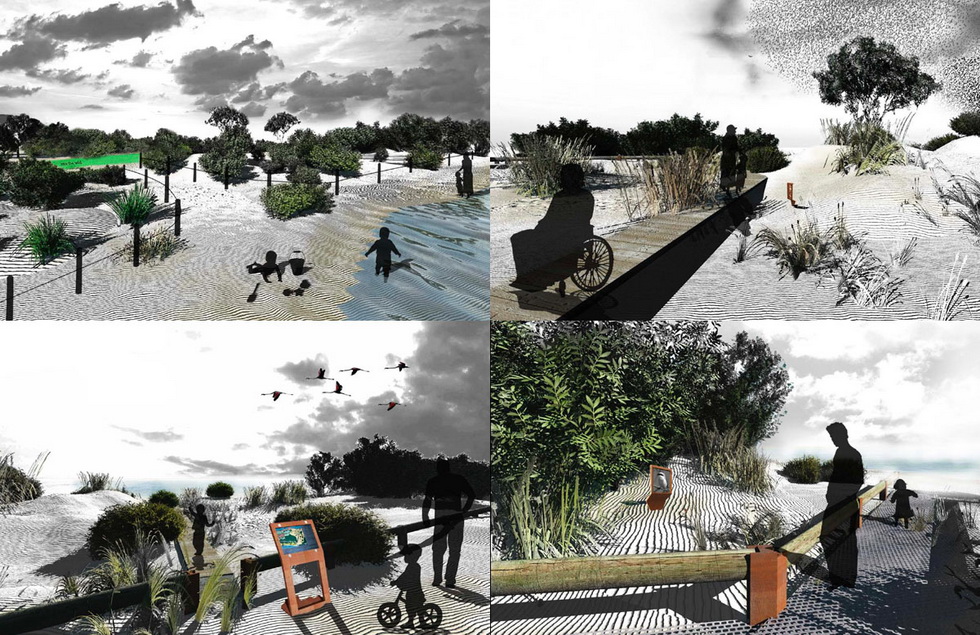
These proposals, however, have never been heard and discussed so far. The proceeding of the H.O.S. - The direction does not leave us, the founders and long-term staff and assistants of the project, any opportunity to conduct serious discussions with the TEMES and to realize any protection measures and future plans in the interest of environmental protection together with the TEMES. A cooperation with the TEMES is, since the start of the first works on this giant construction project for the "touristic development", unavoidable to prevent the worst. We are sure that such a cooperation is only possible with trust and openness as basis.
The naive attempts to praise a concrete rain tank without any shore vegetation or shallow water area as important eco system and balance habitat, have nothing to do with reality and credibility. Instead of attempting real environmental integration, they erected an obviously hostile concrete "lake" which can never turn into an ideal habitat for the specialized animals and plants.
Here is how the German press deals with the topic, in an example of July 2009 in the weekly magazine "Die Zeit":

translation:...a fresh water lake, skilfully integrated into the landscape, have become a piece of nature in which water birds nestle and frogs croak...!
the following pictures are to show how "serious" the so-called facts are presented by journalists of established magazines, obviously without any own research. Because the sad truth looks somewhat different:
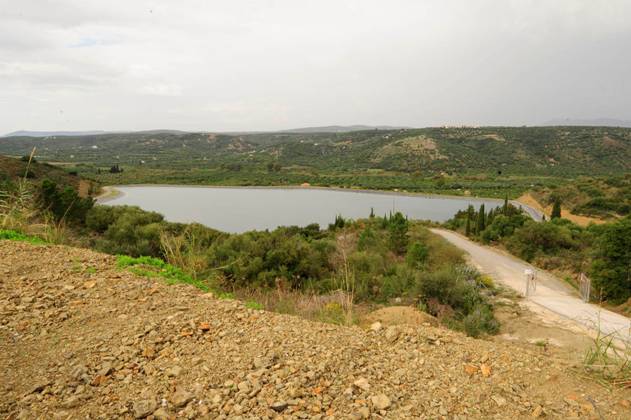
„… skilfully integrated into the landscape ….“

„…,
have become a piece of nature in which water birds nestle, frogs croak …“
The complete (german) article can be seen here:
http://www.zeit.de/2009/32/Costa-Navarino
To get an independent expert opinion, Benny Trapp received the following statement by the NABU (Naturschutzbund Deutschland, German Environment Conservation Agency) to the pictures, without him referring to any problems previously:
Dear Mr. Trapp,
in an answer to your request, read an expertise comment to the pictures of a sea you sent us in the following:
We could not really see with which material the shore area has been made but it is obvious that this is an extremely un-natural design for the complete shore.
We cannot see the reason as there surely would have been alternatives in this area for a complete coverage of the floor.
Another disadvantage for a future development to the sea becoming more natural is the steepness of the shore. This covered, steep slope will make the development of natural substrates difficult or even impossible. There is the danger that this sea will not become natural which will only be habitat
for very few plants and animals.
For cohabitations, the shore area of a sea is most important. The flora here is the basis for a normally very rich fauna of insects, amphibians, birds etc. Considering the unnaturalness these cohabitants will not be able to develop. Species with special habitant requirement will not find a home here. The only species to be expected are ubiquist, which means species that dwell almost everywhere, such as the mallard and other diving ducks, which could be looking for food here.
The aim should be that the shore area of the sea is freed of its stabilization to give natural succession a chance.
With kind regards
Dr. Markus Nipkow
Ornithology and bird protection
______________________________
NABU
Bundesgeschäftsstelle
Charitéstraße 3
D - 10117 Berlin |
It is sad to see how the whole work, the big engagement and the tireless commitment of some hundreds helpers, and the resulting reached interim targets of the protection of the african chameleon are now put in question and endangered. Due to questionable actions and activities of the HOS representatives, the continuation of the urgently required works for a successful nature protection projects are interrupted or stopped. And this at a time where there was some silver lining at the horizon of Pylos concerning the development of the chameleon population. Some of our measures might have been effective, but this could now not mean anything. What stays is bitter taste: irresponsible, not reflected actions and egoistic motifs of the people responsible, which cannot be brought together with constructive protection work for our environment.
We did not get any answer to many of our questions:
- What will the Hellenic Ornithological Society as the responsible institution, against the operators of the Kantina taking over the last habitat of the african chameleon in Europe ?
- Why was the complaint letter of the project staff in 2009 shortened and important things left out?
- Why was this letter not send to the responsible authorities (Department of the Environment, Archaeological Society, police, Mayor's office, TEMES etc.) in time?
- Why was it instead send to the owners of the Kantina, with a copy to the Archaeological Society, with the striking result that the Kantina has become even bigger in the year 2010?
- What is the true reason for the degrading and the dismissal of Marilia Kalouli?
- Why was the requested material for the professional protection work year 2009 not granted, though the finances allowed it?
- Why were outstanding debts of more than 60,000 Euro not paid, despite the sponsoring.
- Which results and arguments justify the payment of Special Consultant Kostas Teneketzis?
- Which results and arguments justify the taking over of the project leadership in 2009 by the Director Mr.Kappas?
A statement of the Hellenic Ornithological Society Would be necessary and could be a basis for a successful continuation of the project. We still hope that the management of the HOS draw appropriate conclusions from the irresponsible behaviour of director Kappas, Special Consultant Teneketzis and others and fills the vacant positions with people who represent the interest of environment protection.
We hope that the Hellenic Ornithological Society does not remain silent any more and takes up the constructive dialogue offered by us, for a common continuation of the protection of endangered species and a beautiful piece of nature. Regarding the threatening changes in the region caused by the construction works of the TEMES project and the successive expansion of the illegal activities of the Kantina, quick action is urgently necessary. An action which takes up the thread on which the chameleons are hanging in the literal sense. It's high high time to take action in the Natura 2000 protection zone.
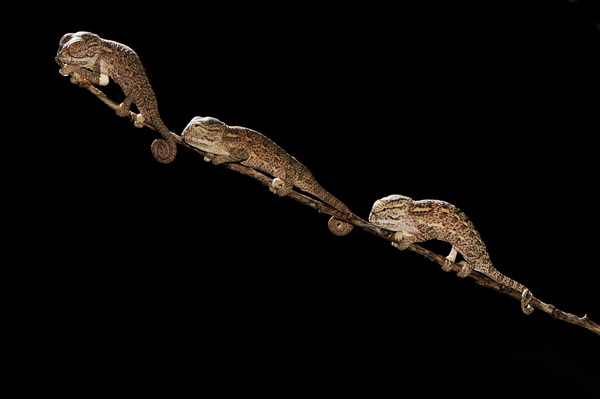
Our target is simple and clear: No harmful touristic usage of the complete habitat within the Natura 2000 area.
We want to continue the protection of the Gialova lagoon, its fauna and flora ans especially the african chameleon in its last and only habitat in Europe. It would be irresponsible to stop the efforts for the protection project and the preservation of a very special animal. We still hope that this unique piece of nature does not disappear behind the profit seeking of individuals and companies. But as long as the circumstances do not change, we cannot count on the positive outcome for the african chameleon. And that though the touristic usage of the area in the sense of eco tourism would be possible based on appropriate plans. Numerous examples of eco tourism projects all over Europe have shown that environment protection and tourism can co-exist, however it showed here that the management of the Hellenic Ornithological Society was not able or willing to realize such a co-existence.
Action must be taken now, before the results of our efforts in the last years are lost irretrievably.
Thank you for your time and your attention!
|